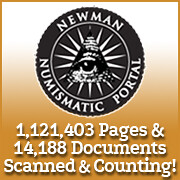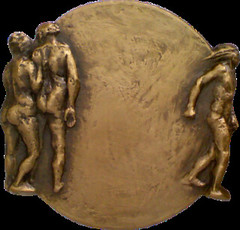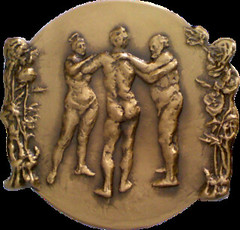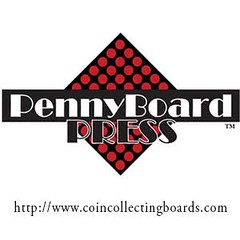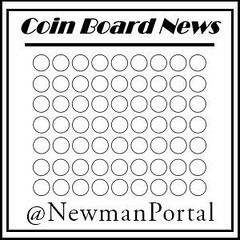
About UsThe Numismatic Bibliomania Society is a non-profit organization devoted to the study and enjoyment of numismatic literature. For more information please see our web site at coinbooks.org SubscriptionsThose wishing to become new E-Sylum subscribers (or wishing to Unsubscribe) can go to the following web page link MembershipThere is a membership application available on the web site Membership Application To join, print the application and return it with your check to the address printed on the application. Print/Digital membership is $40 to addresses in the U.S., and $60 elsewhere. A digital-only membership is available for $25. For those without web access, write to: Terry White, Treasurer
AsylumFor Asylum mailing address changes and other membership questions, contact Terry at this email address: terrywhite5475@yahoo.com SubmissionsTo submit items for publication in The E-Sylum, just Reply to this message, or write to the Editor at this address: whomren@gmail.com BUY THE BOOK BEFORE THE COINSale Calendar
|
- WAYNE'S WORDS: THE E-SYLUM JUNE 11, 2017
- SPINK HOLDS NUMISMATIC LITERATURE FLASH SALE
- CHOPMARKED COINS FEATURED IN 3RD MEGA RED
- NEW BOOK: CURRENCIES OF ANCIENT CHINA
- THE LEADEN TOKENS TELEGRAPH
- IDENTIFYING COINS BY INSCRIPTION FRAGMENTS
- LEONDA FINKE (1922-2017)
- NEW NETHERLANDS NUMISMA ON THE NEWMAN PORTAL
- MORE ON THE ERIE CANAL MEDAL
- NOTES FROM E-SYLUM READERS: JUNE 11, 2017
- MORE ON 'ABER NIT'
- VOCABULARY TERM: ALUMINUM
- BARON DE GUICHAINVILLE (1831-1911+)
- THE MUTILATED CURRENCY DIVISION
- HOW LUCKY COIN SUBMARINE HUNLEY WORKED
- NUMISMATIC NUGGETS: JUNE 11, 2017
- 1938 NEVILLE CHAMBERLAIN MEDAL
- BERTHOLD NEBEL'S MINE SAFETY MEDAL
- MAKING MEDALLIONS AT MIT
- E.T. AND THE ANCIENT PERSIAN DARICS
- A PLUGGED HIGLEY COPPER
- ROYAL CANADIAN MINT COMMEMORATES LOON DOLLAR
- 1090 WORLD CUP PRECURSOR MEDAL
- BRITISH BANKNOTES, SCOTTISH BANKNOTES, AND BEER
- SINGAPORE BANKNOTE DESIGNER PROFILED
- INDIAN NUMISMATISTS RACE TO SAVE BANKNOTES
Click here to access the complete archive
To comment or submit articles, reply to whomren@gmail.com
Content presented in The E-Sylum is not necessarily researched or independently fact-checked, and views expressed do not necessarily represent those of the Numismatic Bibliomania Society.
WAYNE'S WORDS: THE E-SYLUM JUNE 11, 2017
 New subscribers this week include: Ronald Etter, Steve Saller, and Steve Ratliff, courtesy of Duane Feisel. Welcome aboard! We now have 3,249 subscribers.
New subscribers this week include: Ronald Etter, Steve Saller, and Steve Ratliff, courtesy of Duane Feisel. Welcome aboard! We now have 3,249 subscribers.
Thank you for reading The E-Sylum. If you enjoy it, please send me the email addresses of friends you think may enjoy it as well and I'll send them a subscription with your compliments. Contact me at whomren@gmail.com anytime regarding your subscription, or questions, comments or suggestions about our content.
This week we open with a coin book sale from Spink, a note about the new 3rd edition MEGA RED, one new book, a periodical overview and a review of a useful book on coin identification.
Other topics this week include sculptor and medalist Leonda Finke, Neville Chamberlain, the Erie Canal Completion medal, mutilated banknotes, an update on the 'Lucky Coin' Confederate submarine, and the Mine Safety medal.
To learn more about Higley coppers, chopmarked coins, Chinese coinage, English trade tokens, Numisma, doorbell makers, the Jap Statue, saltires, the Navy Medal of Honor, the Baron de Guichainville, and the U.S.-Mexico Border medal, read on. Have a great week, everyone!
Wayne Homren
Editor, The E-Sylum
SPINK HOLDS NUMISMATIC LITERATURE FLASH SALE
Dennis Tucker writes:
Spink is having a flash sale on several numismatic titles (including biographical dictionaries and guides to printed books and periodicals). All for £10 (about $12.50 each, although shipping from England might be a bear for those of us in the U.S.). E-Sylum readers might be interested in checking it out.
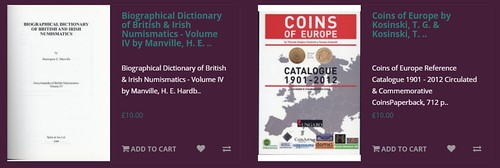
For more information, see:
https://spinkbooks.com/index.php?route=product/category&path=91
THE BOOK BAZARRE
CHOPMARKED COINS FEATURED IN 3RD MEGA RED
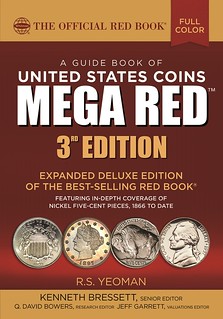 The third edition of MEGA RED (the Deluxe Edition of the Guide Book of United States Coins) features several new appendices covering hobby-related topics. One is a 10-page
illustrated study of chopmarks and chopmarked coins by Colin Gullberg, founder of the Chopmark Collectors Club (a member society of the American Numismatic Association) and editor of Chopmark
News. MEGA RED retails for $49.95 and is available online and from booksellers nationwide.
The third edition of MEGA RED (the Deluxe Edition of the Guide Book of United States Coins) features several new appendices covering hobby-related topics. One is a 10-page
illustrated study of chopmarks and chopmarked coins by Colin Gullberg, founder of the Chopmark Collectors Club (a member society of the American Numismatic Association) and editor of Chopmark
News. MEGA RED retails for $49.95 and is available online and from booksellers nationwide.
Gullberg defines “chops” as personal stamps that intermediaries known as shroffs would punch into inspected silver coins to guarantee they were of good silver and acceptable in trade. The practice started in China in the mid-1600s and took place into the early 1930s. He describes chopmark collecting as an exciting field with many discoveries waiting to be made. “A chopmark collector is like an explorer,” Gullberg writes. “You never know what you will find next.”
The author begins with a history of how silver flowed throughout the world, and especially into China, from the 1500s through the 1800s. He explores the influence of Japan in silver exporting, Europe’s China Trade, and important silver trade coins such as the Spanish 8-reales “cob,” Mexican Portrait or Bust dollars, Pillar dollars, and the famous U.S. trade dollar.
“Most American collectors come into contact with chopmarked coins when they start a trade dollar collection,” Gullberg writes, “yet few have even the scantiest knowledge of this fascinating area of numismatics. Chopmarks played a central role in the use of silver in the China Trade and involved the coinage of dozens of nations and thousands of merchants and money changers over a period of 300 years.”
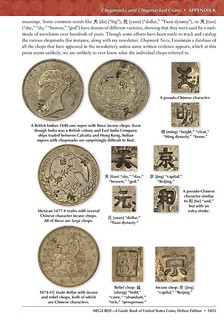 The study is illustrated with 30 photographs of U.S. and foreign coins, and types of chops including incuse and relief, large and small, Chinese characters and pseudo-characters, and even
ink chops. Gullberg also discusses and illustrates assay chops and wedding chops.
The study is illustrated with 30 photographs of U.S. and foreign coins, and types of chops including incuse and relief, large and small, Chinese characters and pseudo-characters, and even
ink chops. Gullberg also discusses and illustrates assay chops and wedding chops.
For collectors, Gullberg analyzes three broad categories of pricing for chopmarked coins: Group 1, comprised of common trade coins from the United States, Britain, Japan, France, and Spain, made specifically for business use in China or commonly circulated there; Group 2, very rare coins, including key dates or mints from Mexico and other countries; and Group 3, non-trade coins commonly found with chopmarks, including Morgan dollars, British shillings, Salvadoran pesos, Russian roubles, and others.
He then lays out his advice for collecting chopmarked coins, giving strategies for focusing on American coins, non-U.S. coins, type coins, and collecting by chop.
About MEGA RED
Billed as the “biggest, most useful Red Book ever,” MEGA RED measures 7 x 10 inches and has 1,040 more pages than the regular edition. The larger size and increased page count combined make MEGA RED
five times bigger than the regular-edition Red Book. It prices 8,200 items in up to 13 grades each, with 48,000 individual values and 15,400 auction records covering circulated, Mint State, and Proof
coinage. The book is illustrated with 7,000 images, including 2,434 that are new to the third edition.
The third edition of MEGA RED officially debuted at the Whitman Coin and Collectibles Baltimore Expo, March 30, 2017, and now is available nationwide. MEGA RED retails for $49.95 and is available online (including at Whitman.com) and from booksellers and hobby shops nationwide. Whitman Publishing is the Official Supplier of the ANA, and Association members receive a 10% discount off all purchases
To read the earlier E-Sylum article, see:
NEW BOOK: MEGA RED 3RD EDITION (http://www.coinbooks.org/v20/esylum_v20n21a05.html)
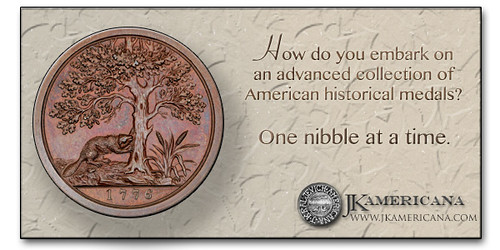
NEW BOOK: CURRENCIES OF ANCIENT CHINA
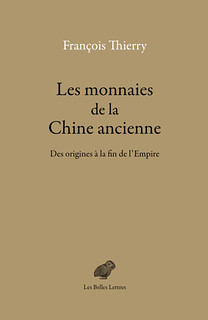 I would like to mention a new book that may be of interest to E-Sylum readers:
I would like to mention a new book that may be of interest to E-Sylum readers:
François Thierry, Les monnaies de la Chine ancienne. Des origines à la fin de l’Empire, published by Les Belles Lettres, Paris, 2017. It’s a paperback, with bibliography, 688 pages, 20 maps, and 370 colour illustrations, 16 x 24 cm, 1310 g, €55.00, ISBN 9782251446868.
I have read the book. And it is a fantastic work. The entire history of Chinese coinage is covered from the very beginnings to 1911. It is unfortunately in French, but I am sure it will become the standard reference on that subject.
A translation of the summary in English is available at
https://chinesemoneymatters.wordpress.com/2017/04/30/francois-thierrys-new-book-on-chinese-coins/
Currencies of Ancient China from Their Origins to the Late Empire
The fruit of several decades of research, this book – a treasure in itself –is currently the most comprehensive reference work on the currencies of ancient China, from their origins to the Late Empire (1911). Mobilizing a wide variety of sources, the author leads readers on a multi-century monetary adventure and, in so doing, maps out a thrilling general history of China.
François Thierry, who is aggregate from University, is the Honorary General Curator of the Département des Monnaies, médailles et antiques(Coins, Medals and Antiques Department ) of Bibliothèque Nationale de France (BNF) and the recipient of the 2006 Medal of the Royal Numismatic Society.
For more information, see:
FRANÇOIS THIERRY Les monnaies de la Chine ancienne
(https://www.lesbelleslettres.com/livre/2902-les-monnaies-de-la-chine-ancienne)

THE LEADEN TOKENS TELEGRAPH
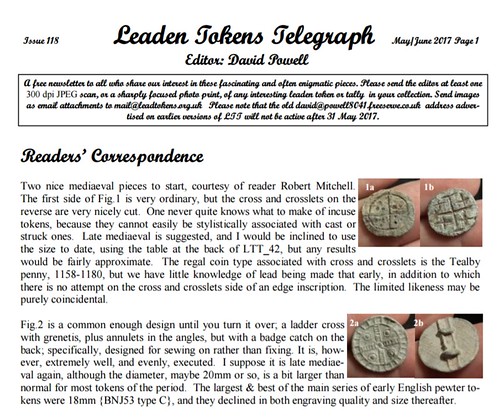
The British Numismatic Chronicle article on early lead and pewter tokens which was mentioned {by Mitchiner and Skinner} is actually spread over two editions, BNJ53 {1983} and BNJ54 {1984}, and is not in the 1984 volume alone. BNJ53 covers the period up to about 1425 and BNJ54 thereafter until the mid-late 17th cent. British lead tokens actually extend up to the early 19th cent but the authors of the BNJ articles appear to have given up on the later ones, probably because they thought them to anarchic to classify.
I have a newsletter, Leaden Tokens Telegraph {LTT}, which has been going since 2005 and which is available, online and free, at www.leadtokens.org.uk . The purpose is to establish communication between metal detectorists and numismatists in this interesting area, to explore the various series and subseries, to float ideas, and to generally show examples and stimulate interest.
At the moment LTT appears around the first of every odd-numbered month, plus December, and is currently up to edition 118. All back numbers are available from the homepage, which also offers an index, a bibliography, and an attempted classification system.
The whole range of British lead and pewter token usage is covered, from 13th cent to 19th, and some of the early pieces which you mention appear from time to time in LTT's pages. Some foreign and ancient material is also included from time to time, although not usually with the same level of detail, and there are also frequent articles which look sideways at trying to explore the interface between lead issues and other better known series, both mainstream and paranumismatic.
To read the earlier E-Sylum article, see:
ENGLAND’S FIRST TRADE TOKENS (http://www.coinbooks.org/v20/esylum_v20n23a22.html)
To read the Leaden Tokens Telegraph , see:
www.leadtokens.org.uk
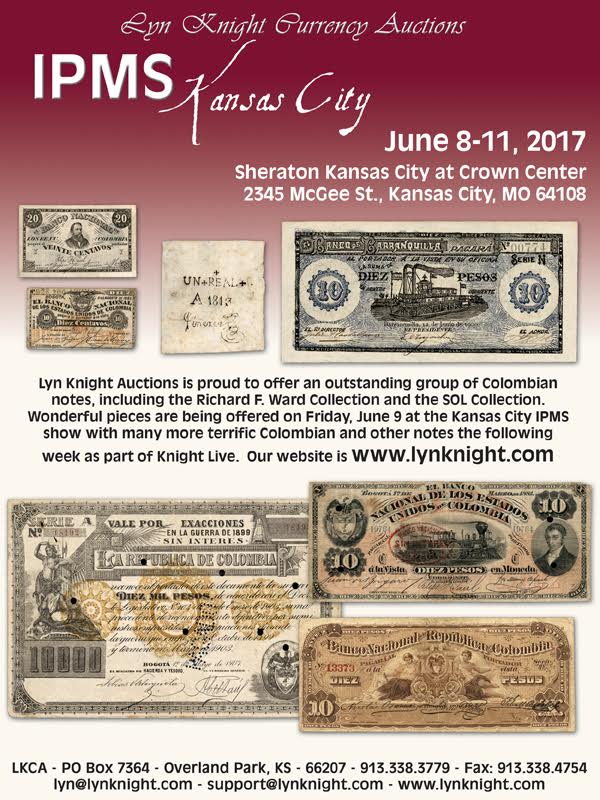
IDENTIFYING COINS BY INSCRIPTION FRAGMENTS
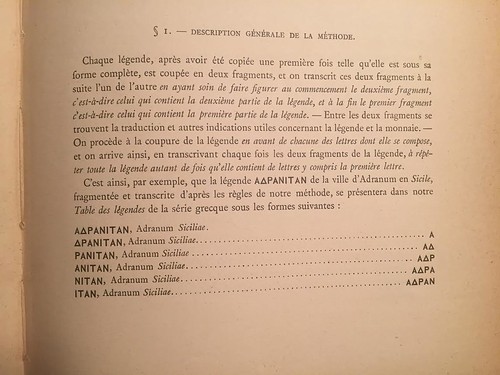
Regarding Jeff Kelley's thorough sleuthing of the fragmentary text on Bill Miller's overstruck Civil War token, Bob Van Arsdell writes:
This method of analysis was used to produce an earlier numismatic work - Séverin Icard's "Identification des Monnaies" in 1929. Icard's book helps you identify ancient coins using fragmentary legends - very helpful when half a coin's legend is off-flan.
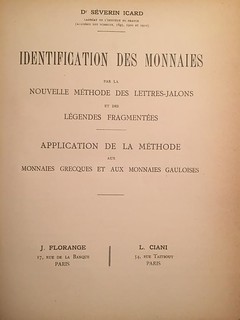
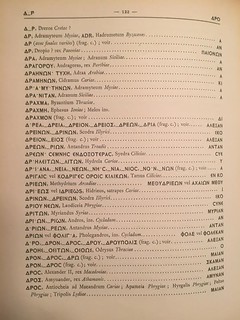
Jeff Rock writes:
How funny that mysteries get solved so quickly -- that baggage tag item had three sleuths working and Voila! Julia never ceases to amaze me with what she is able to find online, and coming up with an exact match image was pretty impressive!
To read the earlier E-Sylum article, see:
MYSTERY BAGGAGE TAG OVERSTRIKING SOLVED (http://www.coinbooks.org/v20/esylum_v20n23a10.html)

LEONDA FINKE (1922-2017)
Originally from New York City, Finke resides on Long Island. Exhibitions of her work have been held in states along the East Coast and in England, Finland, Germany, and Italy. She is represented in collections at The Butler Institute of American Art, Ohio; Brookgreen Gardens, South Carolina; the National Academy of Design, New York; New Jersey's Newark Museum; the National Portrait Gallery and National Museum of American Art in Washington, D.C.; and other major museums, as well as private collections in this country, Japan and Europe. Besides her figurative works, Finke is also recognized internationally for her design and casting of medals, which she has been making since 1986.
Leonda Finke’s sculpture has been primarily concerned with the human figure. “There I find constantly changing forms [and] a wealth of formal vocabulary [that] is a vehicle for expressing the basic emotions that shape our lives.”
Winning her first national prize from the National Association of Women Artists in 1965, she has consistently been recognized for excellence in her work. In 1989 she was awarded the National Sculpture Society’s Gold Medal, in 1990 she received the Alex Ettl Cash Award from the National Academy of Design, and in 1991, 1992, and 1993 she again won prizes and awards from the National Sculpture Society. In 1994 she became an elected Academician of the National Academy of Design.
She has had many solo and group exhibitions, including: Cast Iron Gallery, New York; Newark Museum, New Jersey; the National Academy of Design, New York; the American Numismatic Museum, New York; the Brooklyn Museum of Art, New York; the Norfolk Museum, Virginia; and The Dallas Museum, Texas. Her 6 foot bronze works have been featured in the Contemporary Sculpture Exhibition at Chesterwood, the national historic museum and grounds of the American sculptor, Daniel Chester French, in Stockbridge, Massachusetts.
Leonda Finke’s work in bronze medals has won recognition from the prestigious Federation Internationale de la Medaille. She was invited to show her work at their Medal Exhibition in Helsinki, Finland in 1990. In 1992, she was both an invited lecturer at the British Museum and had her medal, “Virginia Woolf: A Room of One’s Own” featured on the cover of the British Art Medal society’s British Museum Exhibition Catalogue.
Her bronze portrait of Georgia O’Keeffe is in the permanent collection of the Smithsonian Museum’s National Portrait Gallery in Washington, DC. Her medals are in the collection of the British Museum, the National Museum of American History (Smithsonian), the Chrysler Museum in Norfolk, Virginia, and in many private collections throughout the United States and Europe.
To read the complete article, see:
Leonda Finke, American (1922 - ) (http://rogallery.com/Finke_Leonda/finke-biography.html)

To read the complete article, see:
Conversation with Leonda Froehlich Finke (https://www.youtube.com/watch?v=-lvhbdyhKgs)
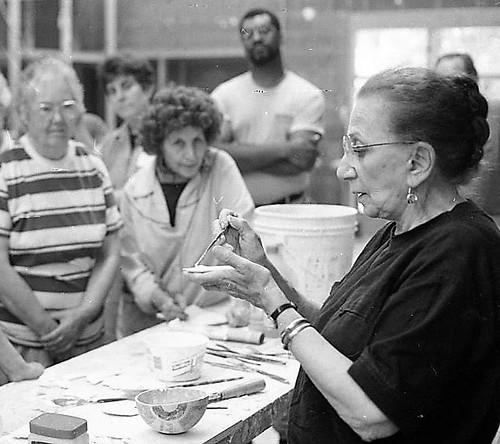
Leonda Finke demonstrating wet plaster modeling technique during the AMSA Hardford conference
Leonda Frosch Finke
Born, Brooklyn NY 1922; Died Roslyn NY 6-6-2017
She studied drawing at the Art Students League and Sculpture at the Educational Alliance. Married the late Arnold Finke, set up a studio in Roslyn Long Island, NY, where she taught privately in a small studio on the property and raised three children.
Solo exhibitions from 1967, group exhibitions from 1986.
Medals:
Brookgreen Gardens Medal, 2007
American Academy of Otolaryngology, 1996
Society of Medallists. Issue #118, Prodigal Son, 1988
British Art Medal Society, Virginia Woolf "A room on one’s own’
Select list of awards:
1984, 1995 National Academy of Design Medal
1989 Gold Medal, National Sculpture Society
1997 J. Sanford Saltus Medal, ANS
2006 Numismatic Award for Excellence in Medallic Sculpture, ANA.
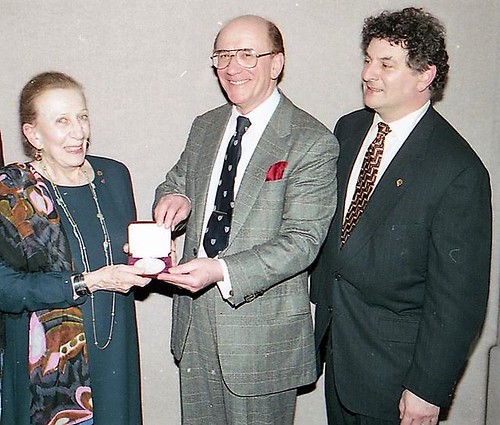
Leonda finke receiving the Saltus Medal from Stephen K. Scher and Alan M. Stahl
Lifesize sculpture can be seen at:
Kingsborough Community College,
Grounds for Sculpture, Hamilton, NJ
Brookgreen Gardens, SC
Academician, National Academy of Design
Fellow, National Sculpture Society
Life Fellow, American Numismatic Society
Founding member, American Medallic Sculpture Association
Member, FIDEM
Member, New York Society of Women Artisits
Member, Sculptors Guild
Member, The Century Association
Past president, Audubon Artists
Conversation with Leonda Froehlich Finke, 2011 Chesterwood Video:
https://www.youtube.com/watch?v=-lvhbdyhKgs
Book:
Leonda Finke
Rudder Finn Press 2006; 288 pages. ISBN: 1932646213, 9781932646214
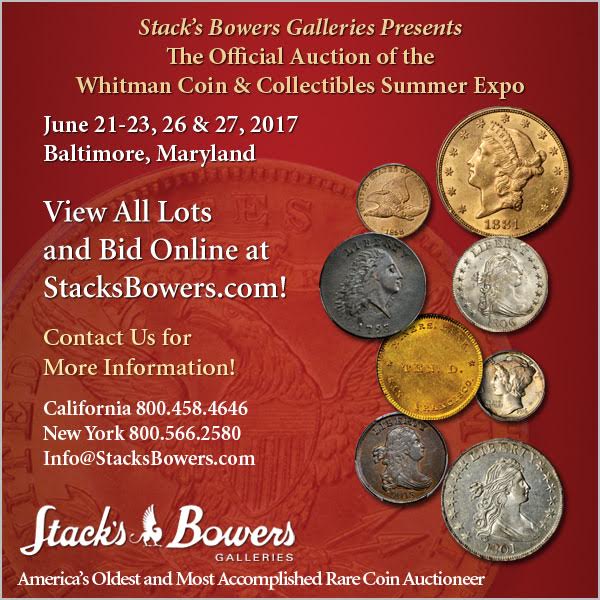
NEW NETHERLANDS NUMISMA ON THE NEWMAN PORTAL
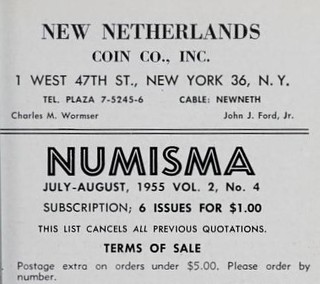 Between 1954 and 1960 the New Netherlands firm issued Numisma, a publication that defies easy classification. It is equal parts house organ, fixed price list, and auction catalog
series. Operated by Charles Wormser and John J. Ford, Jr., New Netherlands was one of the premier firms of its day, raising the bar on cataloging and challenging other firms to match their
expertise.
Between 1954 and 1960 the New Netherlands firm issued Numisma, a publication that defies easy classification. It is equal parts house organ, fixed price list, and auction catalog
series. Operated by Charles Wormser and John J. Ford, Jr., New Netherlands was one of the premier firms of its day, raising the bar on cataloging and challenging other firms to match their
expertise.
The complete Numisma set is 27 issues, and one notices a certain influence on Dave Bowers’ Rare Coin Review, which ran from 1969 to 2003 – contributors to the Q&A column are identified by their initials, and the author’s opinions are liberally sprinkled throughout. The tout ensemble aimed to educate and connect with the reader – what Charles Davis aptly described as “an appealing mix of salesmanship and scholarship.”
Link to Numisma on the Newman Portal:
https://nnp.wustl.edu/library/publisherdetail/518568
Link to New Netherlands auction sale catalogs on Newman Portal:
https://nnp.wustl.edu/library/auctioncompanydetail/27
MORE ON THE ERIE CANAL MEDAL
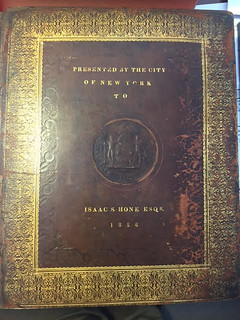
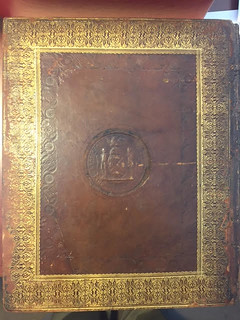
The book is the Memoir written by Cadwallader Colden for the Committee of the Common Council of the City of New York (1826) and presented to the Mayor of NYC at the Celebration of the Completion of the Erie Canal. This particular book was given to his brother, Isaacs Hone (Philip Hone was the NUC mayor during the celebration.
A definition you included in your article last week was incorrect, the wooden boxes were not made from the Seneca Chief but from wood brought on the Seneca Chief to New York City as part of its cargo, per page 348 of the Memoir "this box was made of a piece of Wood, brought from Erie in the first Canal-boat, the Seneca Chief."
Some other aspects of this book that are most interesting are the seven facsimile thank you letters from Charles Carroll, James Madison, James Monroe, John Quincy Adams, the Marquees de Lafayette, John Adams (May 24, 1826) and Thomas Jefferson (June 8th, 1826), as you know the last two died on July 4th 1826 but they both wrote(or signed their names to the thank you letters to the NYC council).
The Memoir also has forty-seven illustrated maps of the Erie Canal project as well as portraits of many participants in the overall celebration.
Truly an awesome book to own.
To read the earlier E-Sylum article, see:
ERIE CANAL COMPLETION MEDAL ORIGINAL BOX (http://www.coinbooks.org/v20/esylum_v20n23a26.html)
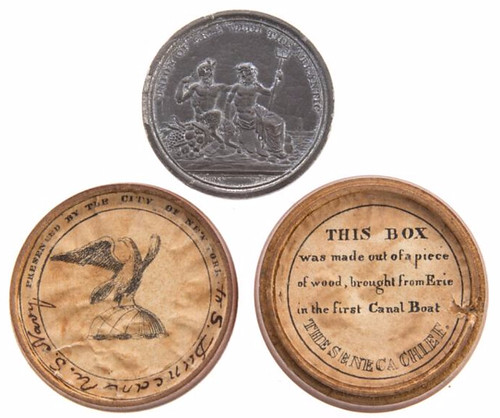
Tony Terranova writes:
Those wood boxes were made by Duncan Phyfe the furniture maker.

NOTES FROM E-SYLUM READERS: JUNE 11, 2017
The New Departure Bell Company
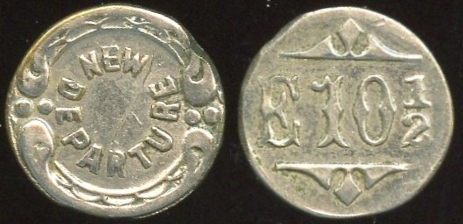
John Phipps of Atlanta, GA. writes:
Regarding the Bristol, CT, New Departure Token in the Feisel Sale, you asked “An interesting whatzit indeed. Does anyone know what this might signify?”
Well, maybe I have a partial answer or clue to the answer. In 1888, brothers Albert & Edward Rockwell started the New Departure Bell Company to make doorbells in Bristol, CT. Later they made bicycle coaster brakes. They had patents in bearing design and manufacturing and made double row and single row bearings for the automotive industry.
In 1916 the company was purchased by William Durant and merged in to United Motors. United Motors was bought outright by General Motors in 1918. For five decades, New Departure was Bristol’s largest employer. When the Bristol plant was closed in the 1995 it was the oldest operating factory in GM. I got nothing on the side with "E 10 ½!"
John adds:
I used to live and work in Dayton, OH when I worked for the Delco Chassis Division of GM. The Bristol, CT Plant was part of our division when it closed. I was still working there at the time.
The token could be a lot of things, Cafeteria or food service token before vending machines, piece work tokens received when turning in full units of production, production control token telling that the next production job was to be "E 10 1/2" bicycle brakes, or a tool claim check or property claim check token. Or the guys in Die Shop could have been having fun with "E"arl when he caught a "10 1/2" fish!!!
To read the earlier E-Sylum article, see:
SELECTIONS FROM THE FEISEL JUNE 2017 TOKEN SALE : Lot 157: Bristol CT, New Departure Token
(http://www.coinbooks.org/v20/esylum_v20n23a18.html)
What is the 'Jap Statue'?
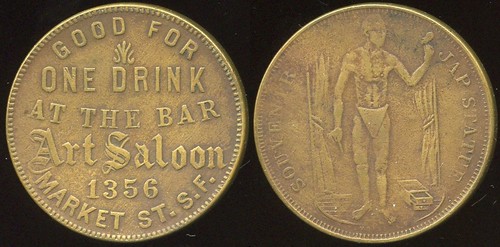
Ken Barr writes:
The token itself is fairly common, but popular, and usually found in well-circulated condition. Five are listed for sale on eBay at present (most are optimistically priced, as usual) and three others have actually sold on eBay in the past two months (for between $41 and $89.99).
I first saw this sculpture as a kid on vacation in San Francisco. It was at the Cliff House at a Ripley museum and later at Fisherman's Wharf if I remember correctly. It is now located at a Ripley museum in Wisconsin.
The artist Hananuma Masakichi was dying of tuberculosis and he endeavored to carve a life-sized sculture of himself. He used his own hair (individually pulled and inserted into small holes), all his hair including eyelashes, etc., his own fingernails, and his own teeth. A description from a historic postcard reads:
The statue is composed of over 2000 separate pieces being hollow with the exception of the feet. The head, thighs, calves, and every member of the anatomy was carved separately and the whole put together. The joints were perfectly made, dovetailed, and glued together -- no metal nails, only wooden pegs or pins beings used to fasten where necessary. After putting all the members together and finishing as far as the woodwork was concerned, he painted and lacquered the statue to give it the flesh and blood appearance; The hairs which adorn the figure belong to himself. He used clippings of his head and ears and each and every hair is bored for and put in one by one. The body hairs were actually pulled from his own body and put in exactly the same position as they occupied on himself. The eyes were also made by the artist and are the wonder of the oculist and optical precision.
The statue is one of those things that sticks in my memory from childhood. I now own a token to remind me of those memories.
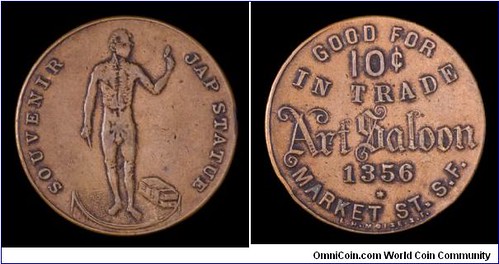
To read the complete article, see:
Jap Statue (http://www.coinpeople.com/index.php/topic/25751-jap-statue/)
To read the earlier E-Sylum article, see:
SELECTIONS FROM THE FEISEL JUNE 2017 TOKEN SALE : Lot 3: Art Saloon Souvenir Jap Statue Token
(http://www.coinbooks.org/v20/esylum_v20n23a18.html)
The Not-So-Secret Mark
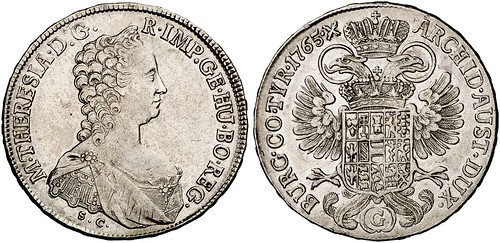
In order for the officials to be able to recognise the "bad" coins, a saltire was put after the year. Of course this "secret mark" did not stay secret for all too long...
Robert Laviana writes:
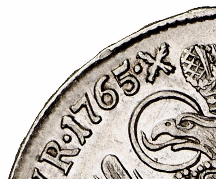 Regarding the Maria Theresa thaler, the "saltire" secret mark is on the illustrated coin...it is the cross or X after the date.
Regarding the Maria Theresa thaler, the "saltire" secret mark is on the illustrated coin...it is the cross or X after the date.
CoinsWeekly editor Ursula Kampmann of Germany writes:
Sometimes it makes sense to read the text and look at the coin. So please take a look at the coin, check its date and behind it you will find the saltire. 'Secret' is relative - in a community where only a small percentage of people were able to read, it might have been a little bit different...
From Google:
another term for St. Andrew's Cross.
(of a design) incorporating a motif based on a saltire cross.
modifier noun: saltire
From Wikipedia:
A saltire, also called Saint Andrew's Cross, is a heraldic symbol in the form of a diagonal cross, like the shape of the letter X in Roman type. The word comes from the Middle French sautoir ("stirrup"), possibly owing to the shape of the triangular areas in the design.
François R. Velde writes:
It's right there on the convention half-thaler of 1765, after the date. The saltire (heraldic term for the St Andrew's cross or diagonal cross, as opposed to upright cross) is visible. It's actually "raguly" that is, has little projections like cut-off boughs on a trunk, and is also known as the cross of Burgundy, used as a badge by the dukes of Burgundy, from whom Maria Theresia descended. It also appears on Spanish coinage.
I don't know if it was really a secret mark, though, or a mint mark
To read the earlier E-Sylum article, see:
THE COINS OF MARIA THERESA (http://www.coinbooks.org/v20/esylum_v20n23a24.html) Saltire
To read the Wikipedia article, see:
(https://en.wikipedia.org/wiki/Saltire)
More on Silver 'Panamint Balls'
Last week we discussed "Panamint Balls" of silver, a purported tactic to thwart robbers by making silver ore t0o heavy to transport without the proper equipment and manpower. Ken Berger
writes:
Something doesn't make sense. Why didn't the bandits just steal the wagon which already held the cannonballs?
Well, there's a lot that doesn't quite make sense in these tales, which is why Bob Van Ryzin believes the story may have been made-up or exaggerated. I wondered about that point myself, but believe the reasoning would be the same general principal in effect today - while you can never completely prevent a determined thief, you can and should make it hard for them.
If the silver was in the form of small bars, robbers could easily carry and conceal them, and blend in with the crowd. If they had to hijack the entire vehicle they would be easier to spot down the road. Prison inmates aren't given orange jumpsuits to prevent them from escaping - they're meant to make them easy to spot if they do escape. -Editor
Ken adds:
I agree. However, I was thinking of how the road may be outside of town, in the middle of nowhere. The bandits would ride in from someplace & steal the wagon & take it to their hideout. Once there, they could then figure out what to do with the silver cannonballs. Or perhaps I just watched too many westerns in my youth.
To read the earlier E-Sylum article, see:
SILVER PANAMINT BALLS REVISITED (http://www.coinbooks.org/v20/esylum_v20n23a27.html)
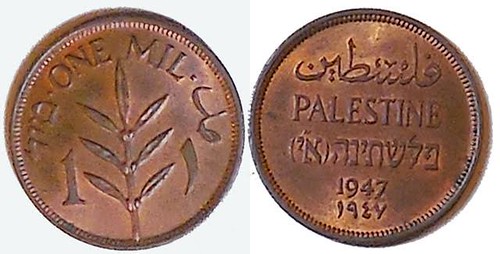
SELECTIONS FROM THE DR. ALAN YORK COLLECTION OF INTERNMENT CAMP AND RELATED PAPER MONEY INCLUDING 3 DIFFERENT NOTES FROM CAMP HAY, NUMEROUS WORLD WAR II RELATED NOTES FROM BRITAIN, ISLE OF MAN, ETC. PLUS A COMPLETE SET OF GIL GIL POW CAMP NOTES FROM KENYA
A NICE SELECTION OF WORLD COINS, TOKENS AND MEDALS IN ALL METALS INCLUDING: ANCIENT AND WORLD COINS INCLUDING MANY CERTIFIED COINS
THE EXCEEDINGLY RARE, AND PERHAPS FINEST KNOWN, 1947 1 MIL COIN OF PALESTINE
HIGH GRADE AND RARE WORLD COINS WITH MANY COINS FROM AFRICA: SOUTHERN RHODESIA 1932 PROOF SET SOUTHERN RHODESIA 1954 2 SHILLINGS OTHER RARITIES FROM SUDAN TO ZANZIBAR
JEWISH RELATED MEDALS, TOKENS AND PAPER MONEY AND MANY OTHER ITEMS
Catalogs will be mailed early to mid-June, send $10 for printed copy or check our website for color images. The sale should be up on our website in early June as well.
LOT VIEWING at Kansas City International Paper Money Show June 8-10, Colorado Springs Coin Show during the break from the ANA Summer Seminar June 21-24.
P.O. Box 785, Littleton, CO 80160-0785
Phone-720-981-0785 Fax-720-981-5345
Cell phone 303 910 8245
Bill@Rosenblumcoins.com
www.rosenblumcoins.com
More on the Navy Medal of Honor
In response to my question last week about a Navy Medal of Honor listed for sale, Tony Swicer of West Palm Beach, FL writes:
The Navy Medal of Honor was issued from 1861 to 1913.
David Klinger writes:
The Medal of Honor in question is a Navy type 4 (1942 or later). The listing implies that the item is a museum reproduction. My article on the subject from 2011 follows
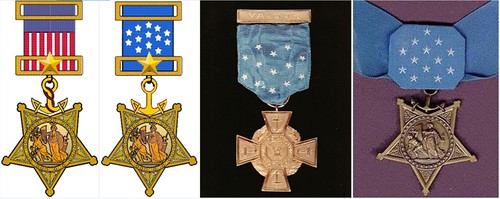
Navy Medal of Honor types
There have been four design types of the Navy Medal of Honor. The Navy was the first to introduce the Medal of Honor. This decoration has been awarded to both Navy and Marine members since 1862.
The first type was introduced in 1862 and was used until 1913. The Navy's Medal of Honor was the first approved and the first designed. The initial work was done at the Philadelphia Mint at the request of Secretary of the Navy Gideon Wells. The design prepared by the Philadelphia firm of William Watson & Sons was the design selected. The central design of Minerva repulsing Discord was symbolic of the Civil War and was used on three of the Navy types and was also used for the first two Army types
The second type was used from 1913 to 1942. Note that the rope was removed from the anchor. And, this was the first time the 13 star pattern was introduced on the Navy ribbon.
The third type referred to as the "Tiffany Cross" Medal was introduced in 1919. Prior to WWII the Medal of Honor could be awarded for both combat and non-combat actions. This rare Tiffany type was only awarded for combat actions. The legend in the center reads: UNITED STATES NAVY 1917-1918. It's not clear to me how many were awarded (somewhere between 7 and 27) - all for action in WWI.
The fourth type is the modern and present version of the medal and was introduced in 1942. As far as I can determine, the first recipient was Chief Petty Officer John Finn for action early on Pearl Harbor Day (7 December 1941).
To read the earlier E-Sylum article, see:
NUMISMATIC NUGGETS: JUNE 4, 2017 : Navy Medal Of Honor (http://www.coinbooks.org/v20/esylum_v20n23a21.html)
Siege Coins and Banknotes of Brazil
First of all, I would like to congratulate you for the excellent work in The E-Sylum. The June 4th edition included pictures from UNAN Numismatica magazine. Some of them are Brazilian coins and banknotes. I am really glad because I am E-Sylum assiduous reading and it's rare to find Brazilian stuff on it.

First, the obsdional coins. They were the first coins with the name "Brasil". At the picture, 12 florins gold coin 1645. The Dutch had invaded Pernambuco and then issued these coins for paying their soldiers. Second, a 2000 réis gold coin 1696 in an excellent shape.
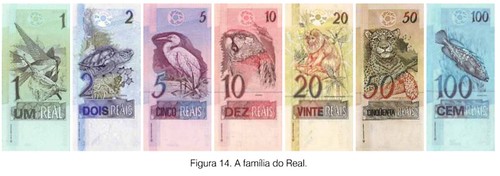
Finally, images from Brazilian real first family banknotes. It's a symbol of the fight of country against hyper inflation. Thank you for keeping E-Sylum. It's a great publication and my favorite way to start the week.
To read the earlier E-Sylum article, see:
UNAN NUMISMATICA MAY-JUNE 2017 PUBLISHED (http://www.coinbooks.org/v20/esylum_v20n23a05.html)
More on the Token and Medal Society
David T. Alexander writes:
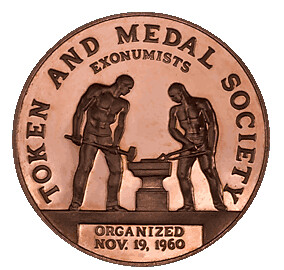 Thank you for Fred Holabird's review of TAMS. A large part of its success was timing, getting started just as American collectors were escaping the straitjacket of coin albums and
Lincoln cents. TAMS also had amazing leadership: Virginia Culver, George Fuld, Jim Curto, Byron Johnson, Cliff Mishler to mention just a few.
Thank you for Fred Holabird's review of TAMS. A large part of its success was timing, getting started just as American collectors were escaping the straitjacket of coin albums and
Lincoln cents. TAMS also had amazing leadership: Virginia Culver, George Fuld, Jim Curto, Byron Johnson, Cliff Mishler to mention just a few.
I agree that while a comprehensive American medal catalog is a great idea, it is also impossible to achieve, thanks to the sheer size of the field.
I believe the best we can hope for will be publication of comprehensive specialized catalogs, personified by Bob Julian's Medals of the U.S. Mint, Neil Musante's recent Medallic Washington and my own American Art Medals. None of these present price guides, however, which will discourage the "what's it worth" crowd.
Worth looking up, if you can find them, are the paperback annual guides to U.S. medals published by a young collector named Clifford Mishler of Vandalia, Michigan, before he became "THE" Cliff Mishler of Iola, Wisconsin. That was long ago, and the volumes published are virtually unknown today.
To read the earlier E-Sylum article, see:
THE ALLURE OF THE TOKEN AND MEDAL SOCIETY (http://www.coinbooks.org/v20/esylum_v20n23a12.html)
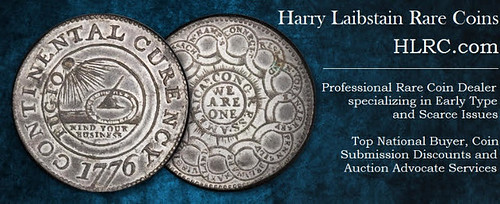
More on The Invisible Empire Tokens
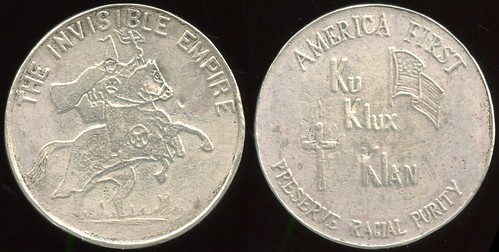
I actually remember the ads for these tokens in several numismatic publications in the early 1960's. The exact entries listed below are from the standard reference catalog for KKK tokens. I have been told that Mr. Birdsell had very good sources for information inside the organization; I do not know his current status. As most collectors are aware, many of the early KKK tokens from the First and Second Movements have been faked (unauthorized copies) and many pure fantasy issues flood the flea markets and swap meets from coast to coast.
Ku Klux Klan Tokens, 2nd Edition, D.E. Birdsell, paperback with card covers, 44 pages, (1st Edition - 1977; unauthorized reprints of both editions are sometimes offered)
KM-301. (1965). A private firm, Cajun Coins of Mandeville, Louisiana, caused this token to be struck during the Centennial Year of the Ku Klux Klan. The issue was not endorsed by any Klan organization; it was commercialized via advertising in collector's trade papers. Forty-nine (49) copies (rim-numbered 1-49) as illustrated (see, incused composition mark in exergue on obverse). Manufactured by acid engraving process. Sterling silver, 37mm.
KM-301.1. (1965). The manufacturer at New Orleans, using 14 gauge metal, acid engraved 4,000 additional copies from same (KM-301) dies toward completing in one operation the variation of metals (and colors) specified on the single order. Aluminum, 37mm.
KM-301.2. (1965). As above, same operation (KM-301) & KM-301.1) produced 1,000 additional copies in anodized gold color to finalize the single order. Aluminum, (anodized), 37mm.
To read the earlier E-Sylum article, see:
SELECTIONS FROM THE FEISEL JUNE 2017 TOKEN SALE : Lot 624: The Invisible Empire
(http://www.coinbooks.org/v20/esylum_v20n23a18.html)
MORE ON 'ABER NIT'
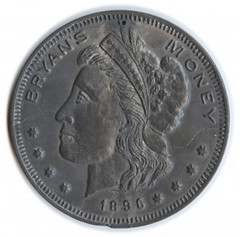
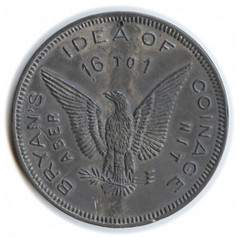
Pete Smith writes:
I came across a reference that says the "ABER NIT" translates as "But Not in Trust."
There is a Bryan piece with legend, "SIXTEEN TO ONE / WE DON'T THINK." Others have a simplified "16 to 1 NIT."
The term "ABER NIT" was used outside of Bryan Money. I think "But Not" might be a good general translation.
Giordano Sereno writes:
You asked readers about the meaning of 'Aber Nit'. I couldn't find this expression. But "Aber Initio" in Latin means "Since the beginning". Is it possible that correct expression was "Aber Initio"?
Ron Haller-Williams writes:
German for "not" is actually "nicht" - "nit" is a dialect (Swabian?) and/or corrupt form.
"Nix and nixy, for no, are debased forms of the German nicht; aber nit, once as popular as camouflage, is obviously aber nicht."
To read the complete article, see:
H.L. Mencken (1880–1956). The American Language. 1921. Page 199 (http://www.bartleby.com/185/pages/page199.html)
William Jennings Bryan" - clue from
http://www.ebay.com/itm/Dated-1896-William-Jennings-Bryan-Bryans-Money-16-To-1-NIT-Political-Medal-89mm/371892411438
http://usamericana.com/bryan-s-money-1896-bryan-s-idea-of-coinage-16-to-1-aber-nit.html
Large lead medal disparaging William Jennings Bryan and his Free Silver platform, 1896. 3 1/2" diameter, nicely struck, and in excellent condition. (This looks like your featured piece.)
https://www.hakes.com/Auction/ItemDetail/44702/THREE-VARIETIES-OF-SATIRICAL-BRYANS-MONEY-FROM-1896-AND-1900-CAMPAIGNS
Each piece is 3.5" dia. designed to resemble an over-sized Liberty head coin. Back of each reads "Bryan's Idea Of Coinage 16 To 1 Aber Nit." (Meaning - "But Not In
Trust") The over-sized coins were to poke fun at the Democrat's proposal of silver to gold coinage in a value ratio of 16 to 1. Many varieties were produced, mostly in 1896. These pieces are
well-executed. The first is white metal with "1896" date and weighs about 6 ounces. The second is also "1896" but with more lead content so weight is just over 8 ounces. The third
piece is like the first except the date was changed in the mold from 1896 to "1900." Minor wear traces. Exc. overall.
https://www.cowanauctions.com/lot/bryan-money-grouping-of-fourteen-coins-96167
(long text, scroll to read in full)
Interesting thread at
https://www.cointalk.com/threads/bryans-money-united-snakes-of-america-medal.249221/
"Looks like a duck [goose!] with the head of a donkey."
http://www.americaslibrary.gov/aa/bryan/aa_bryan_silver_1.html
See also
http://www.americaslibrary.gov/aa/bryan/aa_bryan_subj.html
http://www.americaslibrary.gov/aa/bryan/aa_bryan_causes_1.html (3 pages)
http://www.americaslibrary.gov/aa/bryan/aa_bryan_stand_1.html (3 pages)
http://www.nebraskahistory.org/publish/publicat/history/full-text/NH1964BryanBanking.pdf
To read the earlier E-Sylum article, see:
QUERY: BRYAN MONEY "ABER NIT" INSCRIPTION (http://www.coinbooks.org/v20/esylum_v20n23a28.html)
VOCABULARY TERM: ALUMINUM
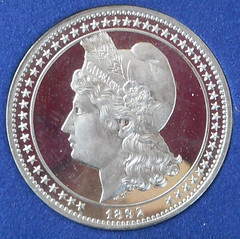
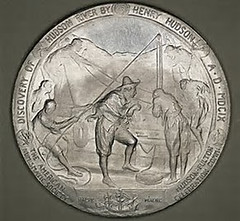
Once aluminum became readily available and inexpensive, by 1880, it was immediately adopted as a low-cost composition for both medals and tokens. A great quantity of electricity is necessary to extract pure aluminum from its ore. Thomas Edison’s inventions of generators and electric transmission provided the necessary electricity. Metalworking firms liked the medal for a wide range of products. Medal makers used aluminum in over 150 different medals for the Columbian Exposition in 1892. This extensive use continued into the 20th century including the 1909 Hudson-Fulton Exposition.
Aluminum. A very light-weight metal in silver-white color. It is used in the 20th century for low value coins and cheaply struck medals; however, when first introduced – at the Paris Exposition of 1855 – it was an expensive and exotic composition.
Aluminum is quite plentiful, the third most common element in the earth's crust (following oxygen and silicon) and the most abundant metal. However it was not isolated until 1825 by Danish physicist Hans Christian Oersted and even until 1855 was available only in small quantities. It remained high in cost well into the 1880s.
Aluminum's light weight was one of its earliest appeals. Napoleon, it is said, liked it for his army's field utensils, and he once gave a banquet in the palace in which the honored guests were served with aluminum utensils and the regular guests with gold!
The early process made pure aluminum by sodium reduction of the molten aluminum chloride. It wasn't until the development of the electric power plant (in 1886) that electricity became available at an inexpensive price to make aluminum in a modern way: electrolysis of purified alumina – aluminum oxide. Aluminum became plentiful in both France and the United States at the same time.
Aluminum medals. The first medal struck in aluminum was the 4-inch Cyrus Field Congressional Medallion of 1858 for laying the Atlantic telegraph cable. The U.S. Mint at Philadelphia struck six aluminum medals in addition to two in gold from the same dies. At that time the aluminum blanks were just as costly as the gold.
The cost of aluminum fell drastically when electrical power became available (by 1890). Another opportunity came at about the same time – the World's Columbian Exposition in Chicago in 1892. Of nearly 600 varieties of medals struck for this occasion, over 150 were struck in aluminum. When the metal became available it was immediately and extensively used for medals!
The Philadelphia Mint experimented by striking 62 medals in aluminum in 1892 (of some 11 varieties of List Medals) but did little in the metal after that. It was the private companies – like Childs of Chicago, Scovill of Waterbury and Quint of Philadelphia – that struck thousands of medals in hundreds of varieties beginning with the 1892-93 exposition.
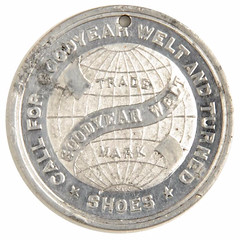
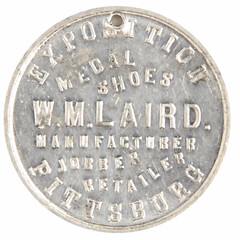
From 1893 to 1910, aluminum and white metal compositions were both sold by diesinking and medallic companies in Europe and America, with aluminum at from one-third to two-thirds the cost of bronze. When numismatists issued medals, like Thomas Elder in the first decade of the twentieth century, they would vend many compositions – Elder offered aluminum alongside white metal, pure tin and pewter as well. Tin became scarce during World War I in America, thus tin-based white metal disappeared and was seldom used for coins and medals thereafter. Use of aluminum, on the other hand, increased vastly, virtually replacing white metal as a low-cost composition for medals.
As one 1892 medal by Childs states, aluminum was "malleable, tasteless, sonorous, ductile, untarnishable;" it also was excellent for coining. When used as a coinage metal it is usually alloyed 96 1/2 aluminum, 3 1/2 magnesium, which increases its wearability slightly.
Once available at low cost, it was immediately embraced by the metalworking industry. Scovill created, in 1894, an aluminum case to house the bronze award medals of the Columbian Exposition. The firm produced 23,000 of both cases and medals.
Aluminum coins. The first coins intended for circulation made of aluminum were stuck by England's Royal Mint for British East Africa and British West Africa. It has served as a composition for low valued coins – and widely used for tokens – ever since. It was used as a wartime alloy in World War II and continued for many countries in Europe, Africa, Asia and Latin America. United States has resisted its used because of verification problems in vending machines.
While ideal for coin relief, aluminum does not have deep drawing capability. It can be easily struck in low relief coins, but cannot easily be struck in high relief objects.
Aluminum is silver-white when freshly cast or polished, but becomes gray when worked, as in coining. In addition to its light weight, aluminum is also different from all other coinage metals in that it can be colored by dyes – forming anodized aluminum. A typical use of anodized aluminum are aluminum throws for parade medals.
British spelling is “aluminium” with two i’s. See composition (2).
CLASS 05.4
Looking for the meaning of a numismatic word, or the description of a term? Try the Newman Numismatic Portal's Numismatic Dictionary at: https://nnp.wustl.edu/library/dictionary

BARON DE GUICHAINVILLE (1831-1911+)
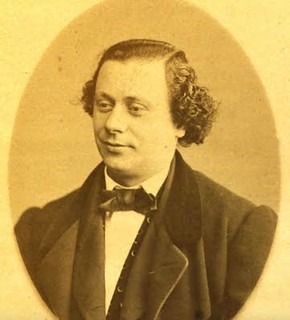 M. Le Métayer-Masselin was a French, Canadian and later American numismatist who was a noted expert on ancient and medieval coins, who has fallen through the proverbial cracks of history
and is now an unknown and rather obscure personality. This biographical sketch was created to reestablish him to the annals of history in the hope of resurrecting him and his son Raoul to the
numismatic fame they rightly deserve.
M. Le Métayer-Masselin was a French, Canadian and later American numismatist who was a noted expert on ancient and medieval coins, who has fallen through the proverbial cracks of history
and is now an unknown and rather obscure personality. This biographical sketch was created to reestablish him to the annals of history in the hope of resurrecting him and his son Raoul to the
numismatic fame they rightly deserve.
Léon Philippe Le Métayer-Masselin, Baron de Guichainville (1831-post 1911), was born in Guichainville, Évreux, Normandy, France. He lived in Bernay in a mansion designed and built by prix de Rome winner, Adolphe Bouveault. He was a French archaeologist, entomologist, and numismatist. In 1861 he was the archaeologist who discovered the so-called Berthouville treasure, which included 3,000 Roman medals and coins in a site he believed was either a city, temple, or cemetery.
His family lost their fortune in the 1870's during the Franco-Prussian War, when his family had borrowed off the estate and the mortgage foreclosed. The de Guichainville family fled as refugees packing what portable valuables they could quickly and easily transport in flight. They emigrated to Montreal, Quebec, Canada circa 1874 to establish a ribbon factory, and M. Le Métayer-Masselin became a dear friend and secretary to the parish priest at Chambly about whom he wrote a pamphlet. While living in Canada M. Le Métayer-Masselin became a member of the Numismatic and Antiquarian Society of Montreal. He donated documents and seals to that Society in September 1877. After his attempt at establishing a ribbon industry failed about 1880, he then moved to New York where he became a naturalized citizen in 1898. There he worked as a private French tutor seeking elite New York families as patrons.
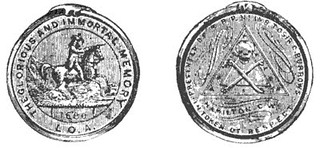 M. Le Métayer-Masselin owned the only known specimen of the William III Orange medal commemorating 1690 and struck in the nineteenth century by J. Belling,[1] a jeweler from Hamilton,
Ontario, Canada, and published in a list on "Canadian Numismatics" by Robert Wallace McLachlan in the American Journal of Numismatics in a series of articles, with the citation of this
piece No. CCLXIV in the January 1881 issue on pages 59-60.
M. Le Métayer-Masselin owned the only known specimen of the William III Orange medal commemorating 1690 and struck in the nineteenth century by J. Belling,[1] a jeweler from Hamilton,
Ontario, Canada, and published in a list on "Canadian Numismatics" by Robert Wallace McLachlan in the American Journal of Numismatics in a series of articles, with the citation of this
piece No. CCLXIV in the January 1881 issue on pages 59-60.
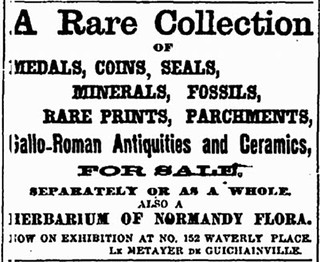 He sold his coin collection and antiques in 1881 in New York. By 1898 he was reported in the New York Journal as being destitute in an article that circulated in newspapers
throughout the United States. In September 1911 he was struck by a trolley car and broke his leg. He lived with his son Raoul and daughters Marie, and Elisa, who was blind.
He sold his coin collection and antiques in 1881 in New York. By 1898 he was reported in the New York Journal as being destitute in an article that circulated in newspapers
throughout the United States. In September 1911 he was struck by a trolley car and broke his leg. He lived with his son Raoul and daughters Marie, and Elisa, who was blind.
Thomas L. Elder had written about the Guichainville family early in 1914 and read from his text as a letter before the New York Numismatic Club on Friday evening, March 13, 1914. Later in 1936, Elder wrote a series of three short essays on the Guichainville family published in Hobbies : The Magazine For Collectors in his monthly column "Recollections of An Old Collector".
To read the complete article, see:
DE GUICHAINVILLE, LÉON PHILIPPE LE MÉTAYER-MASSELIN
(https://sites.google.com/a/numismaticmall.com/www/numismaticmall-com/de-guichainville-leon-p-le-metayer-masselin) 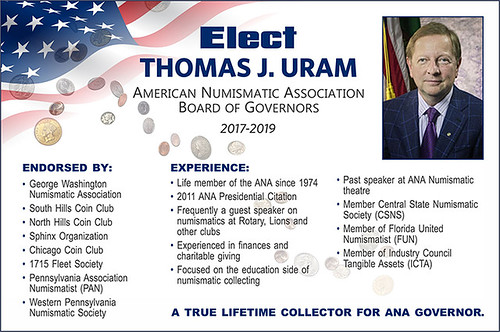
THE MUTILATED CURRENCY DIVISION
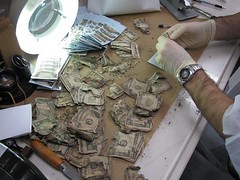 The colorfully named Mutilated Currency Division at the Bureau of Engraving and Printing is a small office of crack forensics that spend their days poring over all manner of defaced
dollars. Provided for free as a public service, the Mutilated Currency employees labor to identify bits and fragments of identifiable denominations that can be redeemed at face value.
The colorfully named Mutilated Currency Division at the Bureau of Engraving and Printing is a small office of crack forensics that spend their days poring over all manner of defaced
dollars. Provided for free as a public service, the Mutilated Currency employees labor to identify bits and fragments of identifiable denominations that can be redeemed at face value.
Established by Congress in 1866—less than five years after the government started issuing paper money—the Mutilated Currency Division handles about 30,000 cases a year, returning currency valued at over $30 million. As long as more than half of the note remains, or the Treasury can be satisfied that the missing portions have been destroyed, the Mutilated Currency Division will redeem the amount of money that has been damaged by fire, water, chemicals, and acts of god.
For understandable reasons, the caseload (and wait time) tends to s.pike around natural disasters. But there are the rare cases with more bizarre origins. Legend has it among BEP tour guides that sometime during the 1970s, a farmer mailed in a rotting cow stomach, desperate for assistance. The man had lost his wallet in the field, and convinced it was eaten by the unfortunate cow, he had promptly slaughtered the beast. The farmer’s hunch proved correct and BEP cut him a check for $600.
The forensic examiners can identify a fleck of printing, and they use advanced scientific methods to determine how much currency was mutilated. Cases usually take between 6 and 36 months, and when payment has been made, the mutilated currency is held securely for 45 days until it is incinerated in a boiler that helps heat and cool the building. The mutilated currency division only handles paper money, but the US Mint has a similar service for melted coins.
Curious about the Mint's program, I reached out to former Mint Director Ed Moy, who writes:
The United States Mint does handle mutilated coins but I’m not sure whether we have a dedicated division. We waffle the coins and outsource their recycling, which includes melting them down.
Coin Procedures
Bent or partial coin is coin that has been bent or twisted out of shape, punched, clipped, plugged, fused, or defaced, but that can be identified as to genuineness and denomination. Bent or partial coin is not redeemable at face value; it is redeemable only at its bullion (metal) value as established by the Director of the U.S. Mint.
To read the complete article, see:
The Mutilated Currency Division (http://www.atlasobscura.com/places/mutilated-currency-division)
To read the Federal Reserve page, see:
Mutilated Currency and Bent or Partial Coin
(https://www.frbservices.org/operations/currency/mutilated_currency_and_coin.html)
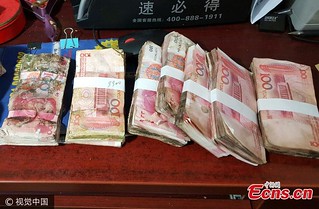 Liu Tiefeng, a staff member at the Industrial and Commercial Bank of China, repairs damaged banknotes in Changchun City, Northeast China’s Jilin Province. A local businessman left 160,000
yuan (24,000) in his garage and later discovered them covered in mildew due to rainwater leaking into the building. With more than 30 years' experience dealing with worn banknotes, Liu washed the
banknotes first with tap water and then with boiling hot water. It took him about three hours to revive all the money, with the exception of one 100-yuan note that was too badly damaged to be
restored.
Liu Tiefeng, a staff member at the Industrial and Commercial Bank of China, repairs damaged banknotes in Changchun City, Northeast China’s Jilin Province. A local businessman left 160,000
yuan (24,000) in his garage and later discovered them covered in mildew due to rainwater leaking into the building. With more than 30 years' experience dealing with worn banknotes, Liu washed the
banknotes first with tap water and then with boiling hot water. It took him about three hours to revive all the money, with the exception of one 100-yuan note that was too badly damaged to be
restored.
To read the complete article, see:
Veteran bank staff uses hot water to clean damaged money (http://www.ecns.cn/visual/hd/2017/06-08/131990.shtml#nextpage)
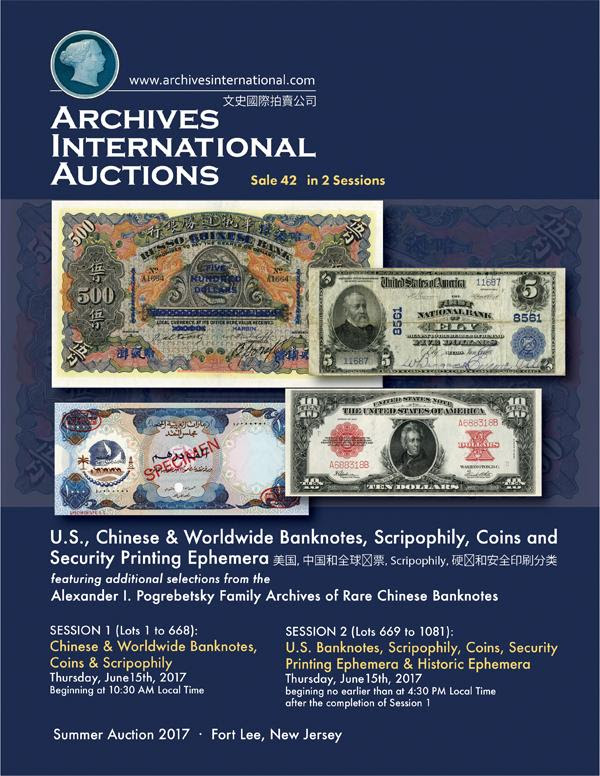
HOW LUCKY COIN SUBMARINE HUNLEY WORKED
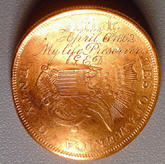 Lt. George Dixon, the sub's commander, carried with him a special $20 gold piece. "Early in the war, in Mobile, Ala., Queenie Bennett (Dixon's fiancee) gave him a $20 gold
piece. While at Shiloh, a Union bullet penetrated his trouser pocket and struck the coin. The impact left the gold piece shaped like a bell, with the bullet embedded in it. If it wasn't for that
coin, he probably would have died on the battlefield and the Hunley might never have made history. He would carry that coin the rest of his life..."
Lt. George Dixon, the sub's commander, carried with him a special $20 gold piece. "Early in the war, in Mobile, Ala., Queenie Bennett (Dixon's fiancee) gave him a $20 gold
piece. While at Shiloh, a Union bullet penetrated his trouser pocket and struck the coin. The impact left the gold piece shaped like a bell, with the bullet embedded in it. If it wasn't for that
coin, he probably would have died on the battlefield and the Hunley might never have made history. He would carry that coin the rest of his life..."
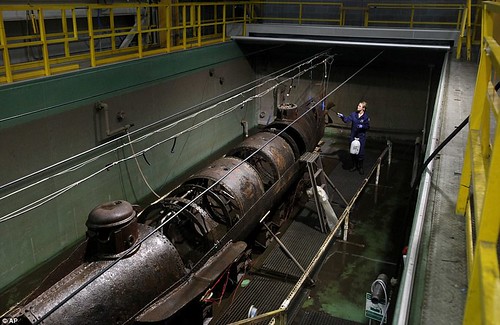
The submarine, which fought for the confederacy in the US civil war, was sunk near North Charleston, South Carolina, in 1864 by its own torpedo, killing all eight men on board.
The Hunley was raised from the bottom of the ocean in 2000, and two scientists have spent the past 17 years collecting the crew's remains and restoring the vessel as part of a painstaking cleanup operation.
While most of the remains were removed and ceremonially buried at Magnolia Cemetery in 2004, the researchers found a tooth stuck in a concrete-like mass of sand, mud and other debris at crank handle position Number 3.
It is believed that this is the position where crew member Frank Collins sat, a Confederate Navy Seaman who was just 24 years old when he sank with the Hunley.
Project lead archaeologist Michael Scafuri told the Post and Courier that the tooth loss was 'post-mortem', meaning that long after the sinking, the tooth came loose during the decomposition process and stuck to the crank handle where it corroded with the iron.
The find was made as the pair of scientists tasked with the submarine's cleanup gave a project update during a media brief this week.
Alongside the tooth, the researchers announced that they had finally cracked how the submarine was propelled through the water.
Hidden underneath the rock-hard stuff scientists call 'concretion' was a sophisticated set of gears and teeth on the crank in the water tube that ran the length of the 40-foot sub.
To read the complete article, see:
American Civil War submarine - that was the first in history to sink an enemy warship - emerges
from a 75,000 gallon tank of chemicals to reveal HUMAN REMAINS (http://www.dailymail.co.uk/sciencetech/article-4584170/Human-remains-inside-H-L-Hunley.html)
To read earlier E-Sylum articles, see:
UPDATE ON THE HUNLEY, THE LUCKY COIN SUBMARINE (http://www.coinbooks.org/esylum_v13n32a16.html)
LATEST MOVE FOR THE HUNLEY, THE LUCKY COIN SUBMARINE (http://www.coinbooks.org/esylum_v14n13a08.html)
THE H.L. HUNLEY LOOKS LIKE A SUBMARINE AGAIN (http://www.coinbooks.org/esylum_v18n38a26.html)

NUMISMATIC NUGGETS: JUNE 11, 2017
Templar Token Breisch & Gesellschaft
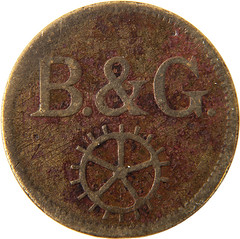
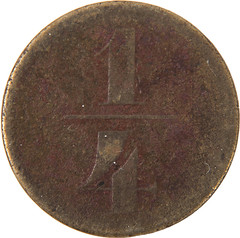
Description: ¼ Piaster token, of a Templar-owned company. Obverse: "B & G" (Breisch & Gesellschaft) with a five-spoked gear bellow. Reverse: denomination. Rare token, unknown to Haffner. The tokens listed in Haffner have the obverse as "B & C" for Breisch and Company. Diameter: 20 mm. VF condition.
To read the complete lot description, see:
Lot 372: Templar Token - ¼ Piaster - Breisch & Gesellschaft (http://www.invaluable.com/auction-lot/-1-c-31F4643B30)
Palestine Railways Token
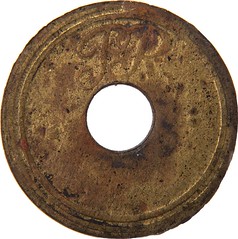
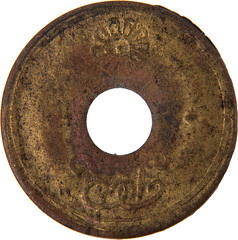
Description: Palestine Railways Token, 1 Piaster. The token was used by British officials of the Palestine Railways. Obverse: the initials "PR" (Palestine Railways). No serial number. Obverse: the initials "PR" with a design on the bottom. Diameter: 29 mm. VF condition. Thinner than other tokens of its type. Unusual edge. Rare. Only very few copies are known worldwide
To read the complete lot description, see:
Lot 374: Palestine Railways Token - 1 Piaster - Without Serial Number (http://www.invaluable.com/auction-lot/-1-c-FDB479BAF0)
1917 U.S. Mexico Border Medal
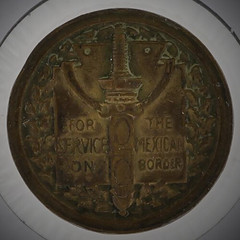
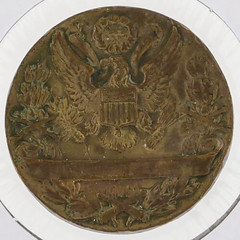
To read the complete lot description, see:
Lot 9: 1917 U.S. Mexico Border Medal (http://www.invaluable.com/auction-lot/-1-c-8F34837AEA)
1938 NEVILLE CHAMBERLAIN MEDAL
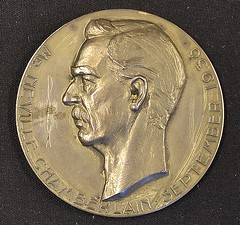 Description: Neville Chamberlain 1938 Plated Medal "Peace in Our Time’ by V. Demanet for Fisch, bust left Neville Chamberlain September 1938 around, PAX vertically in front, measures 7.5mm,
in good condition
Description: Neville Chamberlain 1938 Plated Medal "Peace in Our Time’ by V. Demanet for Fisch, bust left Neville Chamberlain September 1938 around, PAX vertically in front, measures 7.5mm,
in good condition
The scratches detract from this medal, and it's fitting given that Chamberlain's reputation was devastated following WWII. There's nothing funny about war, but history is a funny thing - one never really knows at the time when history is being made. The true course of events seems inevitable only in hindsight.
For more insight I reached across the pond to reader David Pickup, noting "My own country is so split right now the only thing certain is that in the future, half will say "I told you so." whether they actually did or not." David's comments are below. Thank you! -Editor
The medallion is 75 mm not 7.5 mm. Victor Demanet was a Belgian sculptor and Frisch was a Belgian firm.
I think your comments are fair. Hindsight is a wonderful thing. Lots of Conservatives are today saying that Theresa May was wrong to have a general election and her campaign was disappointing. Whether they said it at the time is another question.
Chamberlain was one of a dynasty of Birmingham politicians, many of whom are commemorated on medallions.
Churchill put it like this about Chamberlain:
It fell to Neville Chamberlain in one of the supreme crises of the world to be contradicted by events, to be disappointed in his hopes, and to be deceived and cheated by a wicked man. But what were these hopes in which he was disappointed? What were these wishes in which he was frustrated? What was that faith that was abused? They were surely among the most noble and benevolent instincts of the human heart – the love of peace, the toil for peace, the strife for peace, the pursuit of peace, even at great peril, and certainly to the utter disdain of popularity or clamour. Whatever else history may or may not say about these terrible, tremendous years, we can be sure that Neville Chamberlain acted with perfect sincerity according to his lights and strove to the utmost of his capacity and authority, which were powerful, to save the world from the awful, devastating struggle in which we are now engaged.
To read the complete lot description, see:
Lot 279: Neville Chamberlain 1938 Plated Medal "Peace in Ou (http://www.invaluable.com/auction-lot/-1-c-45A4B21964/)
For more information on Neville Chamberlain, see:
Neville Chamberlain (https://en.wikipedia.org/wiki/Neville_Chamberlain)

BERTHOLD NEBEL'S MINE SAFETY MEDAL
Digest version of The Clarion article published January, 2017
The United States Bureau of Mines (USBM) was established on May 16, 1910 by the Organic Act to deal with a wave of catastrophic mine disasters. 30,000 miners in the US were killed in the first decade of the 20th century. The USBM was dissolved on March 30, 1996. Among its many accomplishments was the creation of programs and technologies that contributed to the reduction of fatalities in mine disasters by 97% from 3,000 in 1907 to 98 in 1993.
A major part of the USBM Mine Safety effort was the sponsorship of Mine Rescue and First Aid Contests in the United States.
In June, 1922 Congress authorized $1,000 for the purchase and bestowal of trophies to be conferred by the Bureau of Mines, at the International Mine Rescue and First Aid Contest, upon miners who have performed noteworthy feats in rescue work in time of mine accidents and disasters. On June 8, The Commission of Fine Arts (CFA) received a letter from the acting director of the Bureau of Mines seeking advice as to the preparation of suitable designs for the trophies which may graphically symbolize the humanitarian efforts of the American miner. James Earle Fraser the sculptor member of the Fine Arts Commission initially suggested Adolph Weinman to sculpt the bas relief but he was not available. Berthold Nebel was his next choice. Nebel worked at the Carnegie Institute in Pittsburgh and his office was within easy walking distance to the USBM Laboratories just across campus. Research was easily accomplished. Nebel submitted designs for the Mine Rescue medal. Below are his final designs.
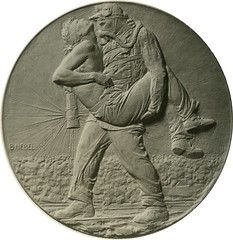
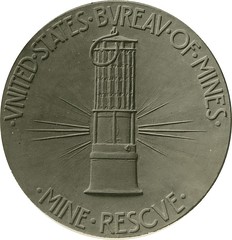
Images Courtesy of the U.S. Commission of Fine Arts
"The obverse and reverse of the full size medal will be mounted side by side, and set in a frame of wood. The engraving proposed to commemorate the award will be placed on a separate plate." So wrote the Chairman of the CFA to Berthold Nebel.
Berthold Nebel (1889-1964) was born in Basel, Switzerland and immigrated to the US with his parents when he was one year old. His family settled in New Jersey and he learned to model in clay working for a decorative terra cotta factory in Perth Amboy, NJ. He studied at night at the National Academy of Design and the Mechanics Institute. He also took classes with James Earle Fraser at the Art Students League and Fraser encouraged him to enter the Grand Prix de Rome competition. Nebel won the sculpture prize and with that a 3-year fellowship (1914-1917) at the American Academy in Rome. At the end of his fellowship, Nebel remained in Italy when the US entered the World War in 1917 and became a supply officer and interpreter for the Red Cross. Berthold Nebel returned to New York in 1920. He worked briefly as an assistant to James Earle Fraser in his McDougal Alley studio before accepting the position of Director of the School of Sculpture at Carnegie Institute of Technology in Pittsburgh, PA. According to Wikipedia Nebel won a competition sponsored by the Bureau of Mines to design and execute a Mine Rescue Medal. No corroboration has been found and it is doubtful a competition took place. The CFA was consulted on this from the beginning and they did not approve of competitions. In reference to another medal, they wrote:
"The Commission deplores the requirement that the production of medals must be submitted to competition, in cases where their production involves an expenditure of more than $500. Unless a medal is produced under the immediate supervision of the artist who designs it, the artist's work is made of no avail." The CFA went on to say. "The Bureau of Mines...consulted the Commission as to a designer. Mr. Berthold Nebel, director of sculpture at the Carnegie Institution of Pittsburgh, was selected. Patient study of the technique of mine rescues and first aid, and frequent conferences with bureau officials on the one hand and this Commission on the other have resulted in medals highly satisfactory to all concerned."
On January 3, 1923 three exhibits opened in the Department of Fine Arts, Carnegie Institute. One was an exhibition of paintings, drawings, designs and small bronzes by alumni of the American Academy of Rome. Berthold Nebel, a Fellow of the American Academy from 1914 to 1918, was represented by designs for the medal he had made for the mine safety work of the United States Bureau of Mines. The review of this exhibit said that Berthold Nebel was not adequately represented. "Nebel has taken what could be such a pedestrian medal as that of the United States Bureau of Mines and he has informed it with nobility. He was limited in the matter of using a gas mask and he has met the unimaginative committee's demand for exact representation of it and yet made this hideous equipment decorative and significant."
On March 8, 1923 the Bureau of Mines again wrote the Commission of Fine Arts asking for assistance in securing a design for a First Aid award. Congress had approved an additional $1,000 in the USBM budget for fiscal year 1923 beginning July 1. The USBM gave the CFA the go ahead to have designs prepared for this award. Since this was to be a companion piece to the Mine Rescue plaque Berthold Nebel got the assignment and the Commission had Nobel's designs for review at their April 5 meeting. Here are the final designs. Nebel requested direction on what the exact wording on the reverse should be.
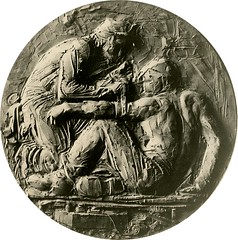
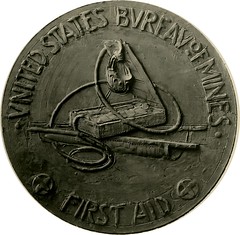
Images Courtesy of the U.S. Commission of Fine Arts
Nebel turned out to be spot on with his query about the copy on the reverse. The Secretary of the Department of the Interior had ordered that the words "Department of the Interior" must appear whenever the words "Bureau of Mines" appear. The chairman of the CFA wrote to the Secretary of the Interior seeking relief from this order. He argued that the models for both medals were about complete and that adding the additional words "Department of the Interior" would overcrowd the medal. He asked that in this instance a waiver be granted, the words be omitted and the design approved. He defended the words 'United States' Bureau of Mines as it was necessary to distinguish the federal bureau from the state bureaus. He also cited the fast approaching August deadline as further reason to approve the medals as designed. In the event the Secretary turned him down.
The 'United States' was reduced to 'US' and made part of the central design. 'US' split the lamp on the reverse of the Mine Rescue medal and was placed just below the stretcher on the First Aid medal. The upper double legend was created to name both the Department and the Bureau. This also led to an odd anomaly in the lettering. The artist had chosen to use the classical Roman tombstone 'V' as a substitute for 'U' in all of the lettering. However, when he moved 'Vnited States' from the legend to the central design of the medal, it became 'US.' This is the only time this writer has seen both 'U' and 'V' used in the same design to mean 'U.' These were the final designs as published by the CFA in 1926. The Department of the Interior got top billing. The first aid obverse and reverse are in the wrong order.
Images Courtesy of the U.S. Commission of Fine Arts
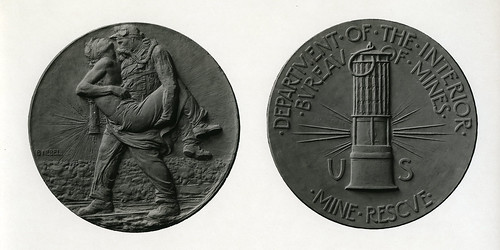
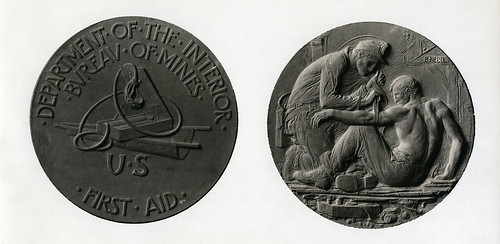
In addition to the plaques the Bureau of Mines intended to award. . ."Two medals, one for the winning team in first-aid and the other for the winning mine rescue team. . . authorized by congress and provided for by a special appropriation. . .designed by a commission of mining men." In the event only one medal was struck. It combined the first aid obverse with the mine rescue reverse. It made sense to use one mine safety medal to recognize the teams competing in both contests. Here is an example of the team medal from 1925 with the loop cropped for ease of illustration.
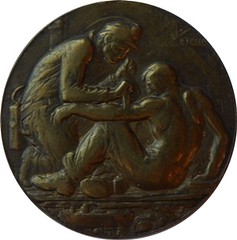
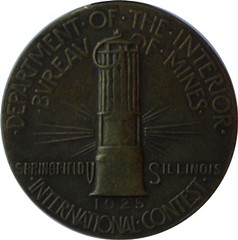
Medallic Art Company, New York (MACo) struck this medal. It is bronze with an integral loop, 1¼-inches in diameter. Only the 1923 issue is edge marked with the maker's name. The MACo No. is 1923-026. It is signed B. Nebel on the obverse in the upper right on the mine shaft ceiling timber support.
On August 27, 28 & 29, 1923, the Seventh International First Aid and Mine Rescue Meet was held at the Bonneville Pavilion in Salt Lake City, UT. 55 first aid teams and 21 mine rescue teams competed. A total of 500 men participated usually in teams of 6. The Benton District team from Benton, IL won the Mine Rescue Contest and the Anaconda Mining Team from Great Falls, MT won the First Aid Contest. The 500 competitors all were recipients of the first Berthold Nebel Mine Safety medal.
In addition to the medals each winning team was awarded the Congressional Bronze Medallion. This was a rectangular wooden board -approximately 1½x2½-feet with a beveled edge on which was mounted two 11-inch bronze circular bas-reliefs; one plaque with Nebel's mine rescue designs and one with his first aid designs. The reliefs were mounted backwards with the reverse to the left and the obverse to the right. Naming the plaque the 'Congressional Bronze Medallion' confused this writer for some time.
With the exception of1924 these 'Congressional Medallions' and Mine Safety Medals were awarded through 1930. After a hiatus of 21 years the contests and awards were resumed in 1951 and continued on odd-numbered years until The Federal Mine Safety and Health Act of 1977 was passed creating the US Mine Safety & Health Administration(MSHA). This new agency began operations March 9, 1978 as part of the Department of Labor. MSHA took over the Mine Safety and Health obligations of the Bureau of Mines. Their continued use of versions of the Nebel Mine Safety Medal and Plaques is an ongoing subject of research.
For more information about the Pennsylvania Association of Numismatists, see:
http://pancoins.org/

MAKING MEDALLIONS AT MIT
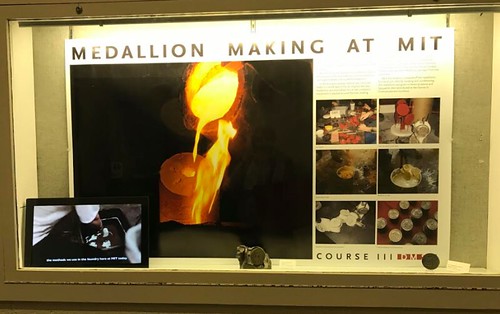
A few years ago, I forwarded to The E-Sylum an article from MIT’s Technology Review about students each year casting bronze medals. While attending my 40th MIT reunion this weekend, I stumbled onto a display related to this program. These heavy, uniface “medallions”, perhaps 2 ½” in diameter, are made using the lost wax process by students in the Department of Material Science and Engineering (DMSE, or Course III in MIT-speak) for the current year’s graduates, as a graduation memento. In addition to examples of unfinished and finished pieces, and a brief description, the display had a running 3-minute video showing the entire process, which you can watch on YouTube. Parenthetically, Eric Newman is also an MIT grad, Class of ’32, so this was his 85th reunion year!

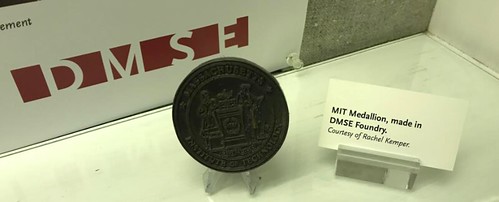
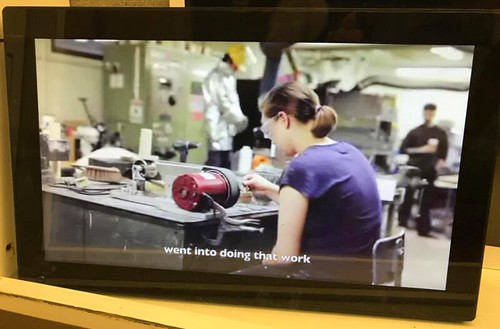
To watch the video, see:
Making Medallions at MIT (https://www.youtube.com/watch?v=PJaryKnfPOQ)
To read the erlier E-Sylum article, see:
MIT FOUNDRY CASTS MEDALS OF SCHOOL SEAL (http://www.coinbooks.org/esylum_v17n26a33.html)
THE BOOK BAZARRE
E.T. AND THE ANCIENT PERSIAN DARICS
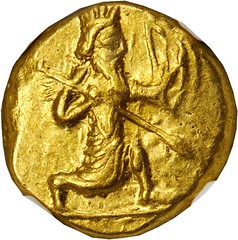
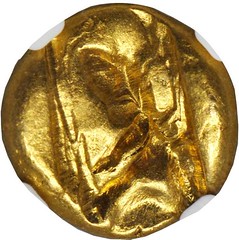
The reverses on ancient Persian darics do not bear a type of any sort. The apparent patterns within the deep incuse area are merely the impression from the punch or similar tool used to drive the coinage metal into the anvil die.
Here is a reverse that might appear to represent a female facing right with a scarf around her neck.
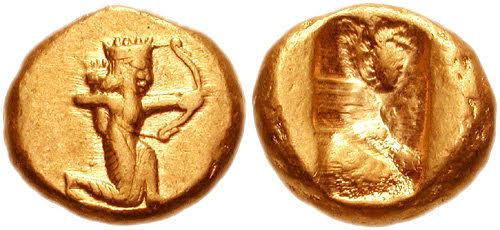
Another might seem to show the head and long neck of the Loch Ness Monster. Similar marks appear on several coins in the archive.
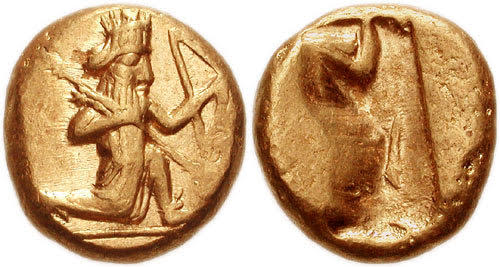
The early coins of Aegina, often considered the first struck in Europe, are not a great deal more sophisticated. The reverses bear an incuse square divided into segments.
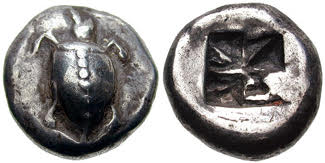
The corresponding silver coins (siglos, plural sigloi) from this era are abundant, though style and artistry vary considerably. This is an attractive one, once again from the CNG archive.
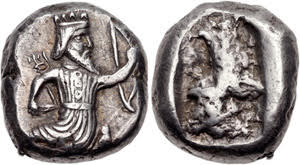
This exercise reminded me of travel in the Rocky Mountains. After a few days you're saying, "It really does look like a Lizard Head."
To read the earlier E-Sylum article, see:
NOTES FROM E-SYLUM READERS: JUNE 4, 2017 : The "E.T." Coin (http://www.coinbooks.org/v20/esylum_v20n23a11.html)
A PLUGGED HIGLEY COPPER
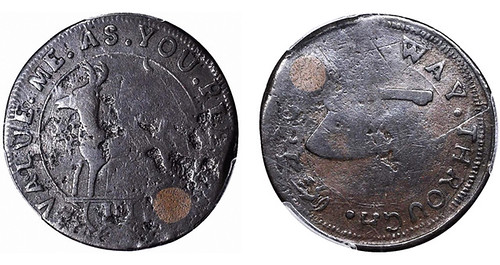
Before the first U.S. coins were struck for widespread circulation at the Philadelphia Mint in 1793, a wide variety of coins circulated in America including a mix of foreign coins and Colonial and Confederation issues. The broad label of “Colonial issues” encompasses multiple major types, and most people’s introduction to this area comes through A Guide Book of United States Coins — the “Red Book” — which lists major varieties. Specialists have gone into exhaustive detail in each of these areas, and the coins aren’t always pretty. Here are three that were offered by Stack’s Bowers Galleries at the Whitman Baltimore Expo that show that these historically important issues don’t have to be attractive to be very expensive.
Higley coppers were independently produced from copper owned by Dr. Samuel Higley’s mine in Connecticut. The tokens were pure copper and many examples show heavy wear. Originally the issue was supposed to be valued as a threepence, but when these were devalued in the areas where they circulated, Higley changed the obverse legend to VALUE ME AS YOU PLEASE.
This undated copper is listed by Dan Freidus as the 3.3-C variety and is traditionally dated to 1737. As the Stack’s Bowers cataloger notes in the description, even attributing the production of these tokens to Dr. Higley is problematic because he died at sea in May 1737 and tokens may have been produced by his son, but that is not confirmed.
These charming issues remain popular, and this one, “a wholesome example for the assigned grade that offers considerable boldness of detail,” is graded Fine Details, Plugged, by Professional Coin Grading Service; the light tan plug at 5 o’clock relative to the obverse is obvious. It sold for $21,150.
To read the complete article, see:
"Wholesome’ undated and plugged Higley copper tops $20,000
(http://www.coinworld.com/news/us-coins/2017/06/wholesome-undated-plugged-higley-copper-twenty-thousand.html)
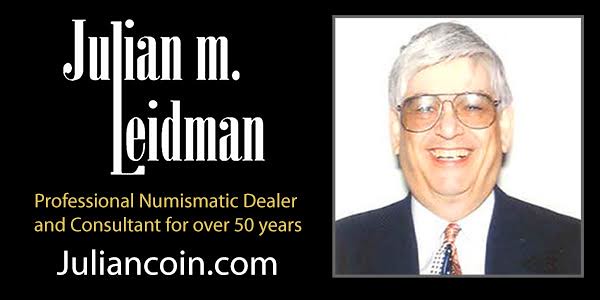
ROYAL CANADIAN MINT COMMEMORATES LOON DOLLAR
In June 1987, Canadians from coast to coast to coast welcomed Canada’s new 11-sided $1 coin in their pockets and change purses.
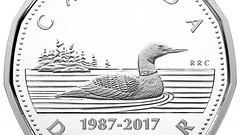 The coin also found its way into our hearts, and was soon dubbed the “loonie” after the solitary loon that graces its reverse side. The introduction of the coin was the most significant
change in Canada’s currency system in almost 50 years. To celebrate the loonie’s birthday, the Royal Canadian Mint has produced a special two-coin numismatic set.
The coin also found its way into our hearts, and was soon dubbed the “loonie” after the solitary loon that graces its reverse side. The introduction of the coin was the most significant
change in Canada’s currency system in almost 50 years. To celebrate the loonie’s birthday, the Royal Canadian Mint has produced a special two-coin numismatic set.
This set features a 99.99 per cent pure silver edition of the now-classic loonie design that graces the reverse of Canada’s $1 circulation coin as designed by Robert Ralph Carmichael. Next to it, the second piece re-creates the coin’s intended
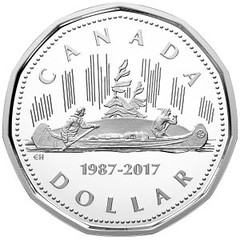 $1 design of the “Voyageur” as designed by Emanuel Hahn. This coin first appeared on the 1935 silver dollar. Both Proof silver coins have a weight of 7.89 grams and a 26.5-mm diameter. The
set has a limited mintage of 10,000.
$1 design of the “Voyageur” as designed by Emanuel Hahn. This coin first appeared on the 1935 silver dollar. Both Proof silver coins have a weight of 7.89 grams and a 26.5-mm diameter. The
set has a limited mintage of 10,000.
To read the complete article, see:
New Issue: RCM marks loonie’s 30th anniversary with commemorate set, including
"Voyageur’ (http://canadiancoinnews.com/mint-marks-loonies-30th-anniversary-commemorate-set-including-voyageur/)
For more information, or to order, see:
$1 Pure Silver 2-Coin Set - 30th Anniversary of the Loonie (2017)
(http://www.mint.ca/store/coins/coin-prod2980025#.WTnhd2jyuAs)

1090 WORLD CUP PRECURSOR MEDAL
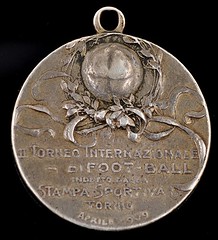 When you hear that a team with "Auckland" in the title won the first football World Cup, two obvious questions immediately come to mind: the first World Cup was surely won by Uruguay in
1930, wasn’t it? And... when have the Kiwis ever been any good at footy?
When you hear that a team with "Auckland" in the title won the first football World Cup, two obvious questions immediately come to mind: the first World Cup was surely won by Uruguay in
1930, wasn’t it? And... when have the Kiwis ever been any good at footy?
But far from the New Zealanders having a football heritage to match the mighty All Blacks at rugby union, this "Auckland in fact refers to West Auckland FC. A team of miners from County Durham in north-east England.
In 1909, this club from the Northern League was invited to compete for the prestigious Sir Thomas Lipton Trophy in Turin, considered by many to be a precursor to today's World Cup.
That trailblazing tournament is recalled in an intriguing lot coming up at the north-eastern auction house Anderson & Garland in Newcastle-upon-Tyne on June 13-15: the winner's medal awarded to Alfred Edwin (Tot) Gubbins of West Auckland FC.
To read the complete article, see:
Medal at auction recalls when England won the first World Cups
(https://www.antiquestradegazette.com/news/2017/medal-at-auction-recalls-when-england-won-the-first-world-cups/)

BRITISH BANKNOTES, SCOTTISH BANKNOTES, AND BEER
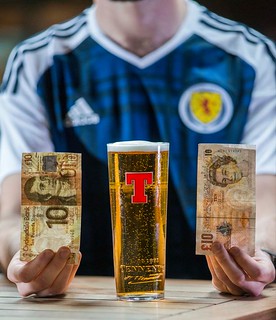 'That's legal tender, pal'. It's the phrase that's wheeled out every time you try to spend Scottish money in England.
'That's legal tender, pal'. It's the phrase that's wheeled out every time you try to spend Scottish money in England.
Whether it’s in a pub, taxi, restaurant or shop, Scots don’t like having their hard earned cash snubbed down south.
Tennent’s Lager are offering the chance to swap your English banknotes for Scottish money ahead of Saturday’s World Cup qualifier with the Auld Enemy.
The Glasgow brewer has launched a campaign called "Here to Serve’.
They’ll be holding a currency exchange on Buchanan Street and then outside Hampden Park and English fans can change their money if they fear their notes will be refused in Glasgow pubs.
The Buchanan street event will take place between 9am and 1pm before moving onto Hampden between 3pm and 5pm ahead of kick-off.
Vouchers for a free taste of Tennent’s will also be available to fans to raise a glass.
Alan McGarrie, Head of UK Brand Marketing at Tennent’s, said: “Our new campaign is all about providing a service to Scots, so we thought the match against England was the perfect opportunity for us to serve up a bit of banter and level the playing field.
"We couldn’t think of a better way to do that than by playing off the long running joke around legal tender.”
To read the complete article, see:
Tennent's Lager turn legal tender argument on England fans ahead of Scotland clash at
Hampden (http://www.glasgowlive.co.uk/whats-on/food-drink-news/tennents-lager-turn-legal-tender-13155330)

SINGAPORE BANKNOTE DESIGNER PROFILED
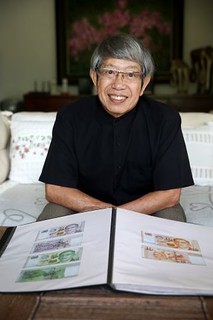 As the first and only Singaporean to date to design an entire series of the Republic’s currency notes, artist Eng Siak Loy, 76, beamed with pride as he spoke about the work spanning five
years and some 530 sketches.
As the first and only Singaporean to date to design an entire series of the Republic’s currency notes, artist Eng Siak Loy, 76, beamed with pride as he spoke about the work spanning five
years and some 530 sketches.
While it was very hard work, it was well worth it, Mr Eng said in an interview last week with TODAY. “As an artist, what is most important is that we can do something for the country,” he said, noting that the notes which he designed would be seen the world over and recognised for generations to come.
His creation, the potrait series bearing the image of Singapore’s first president Yusof Ishak, was introduced in 1999. Having been in circulation for the past 18 years and counting, it is the longest-running currency series here. “From around 1994, I had already begun the work. There were a total of seven denominations for the series from S$2 to S$10,000. I had to learn it all from the start,” he said. “There was a lot of editing and changes… as we had to think of details such as the security needs, the needs for the visually handicapped, the layout of the design. I had to think through carefully in every element of the design to ensure the political, racial and many other aspects were carefully thought out.”
There are a total of four series in Singapore’s currency history - the portrait series was preceded by the ship, bird and orchid series. This year marks the 50th year of circulation for the Singapore currency, with the first notes introduced on June 12, 1967.
Prior to the portrait series, the printers for the previous note series were based in England. Bradbury, Wilkinson & Co printed the S$1, S$5 and S$100 notes for the orchid and bird series, while Thomas De La Rue & Co was commissioned for the S$10, S$25, S$50, S$500, S$1,000 and S$10,000 notes, as well as the entire ship series.
Elaborating on his design, Mr Eng said the back of each note denomination features a unique theme - education, garden city, sports, arts, youth, government or economics - related to Mr Yusof’s biography, which was launched in conjunction with the potrait series.
While Mr Eng had to adhere to the themes set by the design committee, he had free rein on the details and elements to include. For example, the S$5 green banknote featured the garden city theme, and Mr Eng incorporated in the design an image of a Tembusu tree from the Singapore Botanic Gardens. In the background, he included a waterfront and a skyline of buildings.
On the back of the S$2 violet banknote which had the education theme, he drew the old buildings of Victoria Bridge School (now known as Victoria School) and Raffles Institution which Mr Yusof had attended in his youth.
Mr Eng’s art career began with his training at the Singapore Academy of Art in the 1960s. The award-winning artist, who has staged many art exhibitions at home and abroad, is also a prolific designer of Singapore stamps and coins.
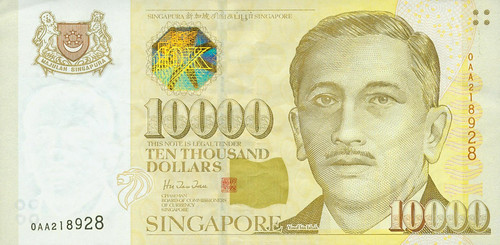
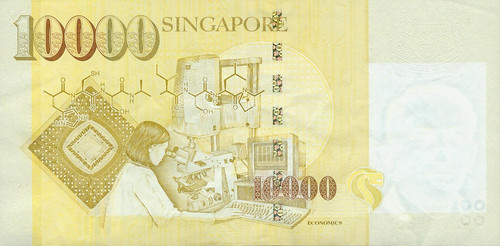
For more information on The Banknote Book, see:
http://www.banknotenews.com/banknote_book/
To read the complete article, see:
Meet the man who designed S’pore’s longest-running currency series
(http://m.todayonline.com/singapore/meet-man-who-designed-spores-longest-running-currency-series)
INDIAN NUMISMATISTS RACE TO SAVE BANKNOTES
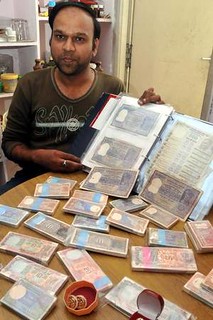 It may not exactly qualify as a Catch-22 situation. But Catch-25, a legacy of demonetisation, certainly comes close to Joseph Heller’s catch in terms of serving up an absurd situation.
It may not exactly qualify as a Catch-22 situation. But Catch-25, a legacy of demonetisation, certainly comes close to Joseph Heller’s catch in terms of serving up an absurd situation.
While debates were raging over the pros and cons of the phasing out of currencies, numismatists were engaged in a discussion of a different sort. They felt that the demonetisation exercise was a call to duty for them: They needed to play the key role of collecting the more than 60 variants of the ₹500 note and the nearly 55 variants of the ₹1,000 note that were released by the Reserve Bank of India till November 8, 2016.
The Specified Bank Notes (Cessation of Liabilities) Act enacted following demonetisation, however, restricts the number of demonetised notes that one can possess for study, research or numismatic purposes to 25. Whoever is found to have in his or her possession more than 25 notes is liable to be fined up to ₹10,000, or five times the value of the note, or whichever is higher. For general purposes, the number of notes is restricted to 10.
Among the variants in a currency could be the change of RBI Governor as the note carries his or her signature, or the colour changes introduced over a period of time. Variants also had Braille while security threads and security designs were changed from time to time. “Till 2006, the year of print was not on the note. The rupee logo was added in 2011 while the telescopic number was introduced in 2016,” a collector said on condition of anonymity.
Record for posterity
“Notes and coins help one understand the history and the progress of a nation. Collectors should be allowed to hold at least one note of each variant so that this history is preserved for posterity,”
said Rajender Maru, Treasurer of the Indian chapter of the International Bank Note Society, which was established in 1961 to promote the study of bank notes and has chapters in 90 countries.
Though this has been brought to the notice of the government nothing has been done so far.
To read the complete article, see:
Numismatists in a fix after note ban
(http://www.thehindu.com/news/national/numismatists-in-a-fix-after-note-ban/article18951779.ece)

